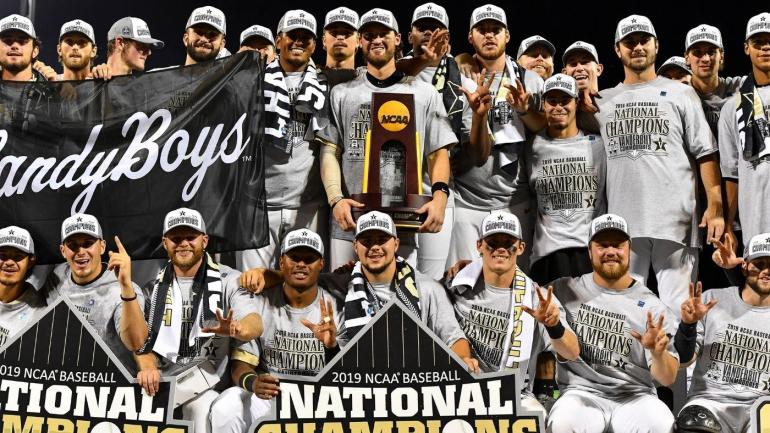
On Monday, the selection committee announced the field of 64 for the 2021 NCAA Division I Baseball Tournament, which we'll unveil in a moment.
Before we jump in, you should know that the structure of the NCAA Baseball Tournament is a bit different from the more familiar hoops variant. Here are a few takeaways on that front ...
- The field this year includes 30 automatic bids via conference championships and 34 at-large entrants. The first round of play is known as the regional, and it's a round-robin, double-elimination format. Each of the 16 No. 1 seeds hosts its respective regional, when possible. Each of the 16 regionals are seeded one through four. In each region, No. 1 faces No. 4, and No. 2 faces No. 3 on the first day of action. The winners of those two games then play each other, while the losers play an elimination game.
- The winner of each regional advances to the super regional. The super regional is a best-of-three series format.
- The winners of the super regionals -- eight teams in all -- advance to the College World Series in Omaha.
- The College World Series is a double-elimination format until the final two teams are left standing. At that point, slates are wiped clean, and it's a best-of-three series to determine the national champion.
- The field of 64 also includes eight national seeds, which you may consider the pre-tourney favorites to reach Omaha. Here they are for this year, ranked in order with their regular-season record:
- Arkansas, 46-10
- Texas, 42-15
- Tennessee, 45-16
- Vanderbilt, 40-15
- Arizona, 40-15
- TCU, 40-17
- Mississippi State, 40-15
- Texas Tech, 36-15
If a national seed wins its region, then it hosts the super regional when possible. Otherwise, the sites of the super regionals will be announced after the regional round concludes.
Regional play gets underway on Friday, June 4. Now here are the matchups for all 16 regionals (each region is seeded one through four).
Austin Regional
- #1 Texas (42-15) vs. #4 Southern U. (20-28)
- #2 Arizona State (32-20) vs. #3 Fairfield (37-3)
Columbia Regional
- #1 Old Dominion (42-14) vs. #4 Jacksonville (16-32)
- #2 South Carolina (33-21) vs. #3 Virginia (29-23)
Eugene Regional
- #1 Oregon (37-14) vs. Central Connecticut State (28-13)
- #2 Gonzaga (33-17) vs. #3 LSU (34-22)
Fayetteville Regional
- #1 Arkansas (46-10) vs. #4 NJIT (26-22)
- #2 Nebraska (31-12) vs. #3 Northeastern (36-10)
Fort Worth Regional
- #1 TCU (40-17) vs. #4 McNeese (32-28)
- #2 Oregon State (34-22) vs. #3 Dallas Baptist (37-15)
Gainesville Regional
- #1 Florida (38-20) vs. #4 South Florida (28-27)
- #2 Miami (Fla.) (32-19) vs. #3 South Alabama (33-20)
Greenville Regional
- #1 East Carolina (41-15) vs. #4 Norfolk State (25-26)
- #2 Charlotte (39-19) vs. #3 Maryland (28-16)
Knoxville Regional
- #1 Tennessee (45-16) vs. #4 Wright State (35-11)
- #2 Duke (32-20) vs. #3 Liberty (39-14)
Lubbock Regional
- #1 Texas Tech (36-15) vs. #4 Army (28-23)
- #2 UCLA (35-18) vs. #3 North Carolina (27-25)
Nashville Regional
- #1 Vanderbilt (40-15) vs. #4 Presbyterian (22-21)
- #2 Georgia Tech (29-23) vs. #3 Indiana State (30-19)
Oxford Regional
- #1 Ole Miss (41-19) vs. #4 Southeast Missouri State (30-20)
- #2 Southern Miss (37-19) vs. #3 Florida State (30-22)
Ruston Regional
- #1 Louisiana Tech (40-18) vs. #4 Rider (23-16)
- #2 NC State (30-17) vs. #3 Alabama (31-24)
South Bend Regional
- #1 Notre Dame (30-11) vs. #4 Central Michigan (40-16)
- #2 UConn (33-17) vs. #3 Michigan (27-17)
Stanford Regional
- #1 Stanford (33-14) vs. #4 North Dakota State (41-17)
- #2 UC Irvine (40-16) vs. #3 Nevada (25-18)
Starkville Regional
- #1 Mississippi State (40-15) vs. #4 Samford (35-22)
- #2 VCU (37-14) vs. #3 Campbell (35-16)
Tucson Regional
- #1 Arizona (40-15) vs. #4 Grand Canyon (39-19-1)
- #2 Oklahoma State (35-17-1) vs. #3 UC Santa Barbara (39-18)
And here's a link to NCAA.com's bracket, which includes region vs. region pairings for the super regionals.
Finally, here's a rundown of the conferences that received multiple bids for 2021 (via NCAA.com) ...
| Bids by conference | |
|---|---|
| Southeastern | 9 (Alabama, Arkansas, Florida, LSU, Mississippi St., Ole Miss, South Carolina, Tennessee, Vanderbilt) |
| Atlantic Coast | 8 (Duke, Florida St., Georgia Tech, Miami-FL, NC State, North Carolina, Notre Dame, Virginia) |
| Pac-12 | 6 (Arizona, Arizona St., Oregon, Oregon St., Stanford, UCLA) |
| Big 12 | 4 (Oklahoma St., TCU, Texas, Texas Tech) |
| Conference USA | 4 (Charlotte, Louisiana Tech, Old Dominion, Southern Miss.) |
| Big Ten | 3 (Maryland, Michigan, Nebraska) |
| American Athletic | 2 (East Carolina, South Fla.) |
| Atlantic Sun | 2 (Jacksonville, Liberty) |
| Big South | 2 (Campbell, Presbyterian) |
| Big West | 2 (UC Irvine, UC Santa Barbara) |
| Metro Atlantic | 2 (Fairfield, Rider) |
| Missouri Valley | 2 (Dallas Baptist, Indiana St.) |
The Ivy League opted not to play the 2021 season on account of the COVID-19 pandemic, which means no conference representative in the field of 64. As well, the Big Ten played a conference-only schedule this season, which made it quite difficult for the selection committee to evaluate the at-large bid cases for Big Ten teams. Bubble team Indiana missed out on a bid. Speaking of bubble teams, a rule of thumb is that any power conference team that's a third seed in a region was probably on the bubble to some extent.
As you can see, the SEC lords over all. It fetched nine bids and three of the top four overall seeds. In all seven of the 16 regionals this year are being hosted by SEC schools. To put a finer point on it, Alabama and LSU nabbed at-large berths despite going 12-17 and 13-17, respectively, in conference play. To the extent that there's any such thing as a "heavy favorite" heading into the many-layered tourney, mighty Arkansas is it.
Again, regional action gets underway on Friday, and it all leads up to the College World Series in Omaha, which starts on Saturday, June 19.
So, who ya got?






















